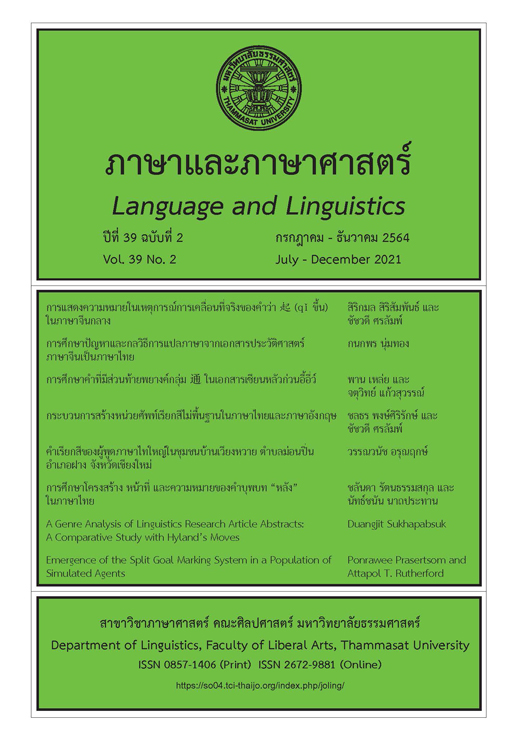The Study of Syntactic Structures, Functions, and Meanings of /lǎŋ/ in Thai
Main Article Content
Abstract
The objective of this study is to illustrate syntactic structures, functions, and meanings of the word, /lǎŋ/, in Thai. The data were retrieved from the Thai National Corpus (TNC). The results revealed two main patterns of the preposition, /lǎŋ/, that preceded nouns and verbs. The preposition, /lǎŋ/, preceding nouns, functioned as the head of the prepositional phrase in conjunction with the noun. It could be divided into two subtypes: one that preceded the locational noun and one that preceded the temporal noun. The first subtype conveyed spatial meaning; that is, “a position or side that is opposite to the front,” and the latter subtype conveyed “time.” When it preceeded verbs, the preposition /lǎŋ/ normally arose at the beginning of the clause. Here it functioned as a subordinator, known as a connector, and conveyed “sequence.”
Article Details
บทความทุกบทความเป็นลิขสิทธิ์ของภาษาและภาษาศาสตร์
References
กิ่งกาญจน์ เทพกาญจนา. (2559). Grammaticalization กระบวนการกลายเป็นรูปไวยากรณ์. โครงการเผยแพร่ผลงานวิชาการ ฝ่ายวิจัย คณะอักษรศาสตร์ จุฬาลงกรณ์มหาวิทยาลัย.
นพดล นันทสุขเกษม. (2556). อรรถวากยสัมพันธ์ของคำว่า “ยัง” ในภาษาไทย ตามแนวแบบลักษณ์ภาษา [วิทยานิพนธ์ปริญญาดุษฎีบัณฑิต]. มหาวิทยาลัยเกษตรศาสตร์.
นววรรณ พันธุเมธา. (2549). ไวยากรณ์ไทย. โรงพิมพ์แห่งจุฬาลงกรณ์มหาวิทยาลัย.
นันทนา วงษ์ไทย. (2562). อรรถศาสตร์ปริชานเบื้องต้น. เวิร์ค ออล พริ๊นท์.
ราชบัณฑิตสถาน. (2554). พจนานุกรม ฉบับราราชบัณฑิตสถาน พ.ศ. 2554. http://www.royin.go.th/dictionary/
วิจินตน์ ภาณุพงศ์. (2520). โครงสร้างภาษาไทย. โรงพิมพ์มหาวิทยาลัยรามคำแหง.
ศุภชัย ต๊ะวิชัย. (2556). มโนทัศน์พื้นที่ในภาษาไทย: กรณีศึกษาคำว่า “หลัง” ที่ปรากฏบนเว็บไซต์พันทิปดอทคอม. คณะอักษรศาสตร์ มหาวิทยาลัยศิลปากร.
อมรา ประสิทธิ์รัฐสินธุ์. (2556). ชนิดของคำในภาษาไทย: การวิเคราะห์ทางวากยสัมพันธ์. โรงพิมพ์แห่งจุฬาลงกรณ์มหาวิทยาลัย.
อมรา ประสิทธิ์รัฐสินธุ์, กิติมา อินทรัมพรรย์, และนัฐวุฒิ ไชยเจริญ. (2554). ไวยากรณ์ไทยฉบับครอบคลุมภาษาย่อย. สำนักงานกองทุนสนับสนุนการวิจัย.
อุดม วโรตม์สิกขดิตถ์. (2555). ไวยากรณ์ไทยในภาษาศาสตร์ (พิมพ์ครั้งที่ 5). สำนักพิมพ์มหาวิทยาลัยรามคำแหง.
อุปกิตศิลปสาร, พระยา. (2546). หลักภาษาไทย: อักขรวิธี วจีวิภาค วากยสัมพันธ์ ฉันทลักษณ์ (พิมพ์ครั้งที่ 12). สำนักพิมพ์ไทยวัฒนาพานิช.
Chen, C. (2014). A Contrastive study of time as space metaphor in English and Chinese. Theory and Practice in Language Studies, 4(1), 129-136.
Evans, V. (2005). The meaning of time: Polysemy, the lexicon and conceptual structure. J. Linguistics, 41(1), 35-75.
Evans, V., & Green, M. (2006). Cognitive linguistics: An introduction. Edinburgh University Press.
Kullavanijaya, P. (2003). A historical study of time markers in Thai. Manusya: Journal of Humanities, Special Issue(6), 87-106.
Tyler, A., & Evans, V. (2003). The semantics of English prepositions: Spatial scenes, embodied meaning, and cognition. Cambridge University Press.
Wu, F. (2008). Origin and evolution of the locative term hòu ‘back’ in Chinese. In D. Xu (Ed.), Space in languages of China: Cross-linguistic, synchronic and diachronic perspectives (pp. 229-247). Springer.
Yamane, T. (1973). Statistics: An introductory analysis (3rd ed). Harper and Row Publications.


